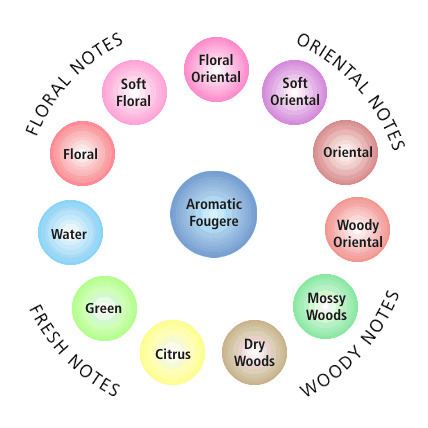 | ||
The Fragrance Wheel is a fragrance classification chart first developed in 1983 by Michael Edwards, a consultant in the fragrance industry. The wheel is a method for perfume classification which he first designed after being inspired by a fragrance seminar by Firmenich, and seeks to show the relationships between each individual fragrance family. The fragrance wheel has been shown to be highly consistent with previous studies on odor descriptor and odor profile representations.
Contents
The chart was first created in an attempt to develop a fragrance classification method and naming scheme without technical jargon that can be used in consumer settings by retailers. The main purpose of the wheel is to allow a retailer to suggest different fragrances in a similar category to ones that their customers may prefer, which has been put into use by retailers such as Sephora and Nordstrom.
Fragrance Chart
Since its creation, the wheel and the developed fragrance classification scheme has been modified several times through the addition of different groups to encompass different fragrance types.
The four standard families are Floral, Oriental, Woody and Fresh. These are in turn divided into three sub-groups (e.g. in the Floral Family: Floral, Soft Floral, Floral Oriental) and arranged in a circle, each group being related to the next. Each of the subclasses were in turn divided into Fresh, Crisp, Classical, and Rich compositions. Prior to 2010 Fougère family was placed at the center of this wheel since they are a large family of scents that usually contain fragrance elements from each of the other four families; citrus from the fresh family, oak moss and woods from the woody family, coumarin and incense from the Oriental family, and lavender from the floral family.
In this classification scheme, Chanel No.5, which is traditionally classified as a "Floral Aldehyde" would be located under Soft Floral sub-group, and "Amber" scents would be placed within the Oriental group. As a class, Chypres are more difficult to place since they would be located under parts of the Oriental and Woody families. For instance, Guerlain Mitsouko, which is classically identified as a chypre will be placed under Mossy Woods, but Hermès Rouge, a chypre with more floral character, would be placed under Floral Oriental. Originally they are:
With the publication of Fragrances of the World 2008, two new sub-groups: Fruity and Woods, have been added to the wheel.
The chart was again modified in 2010, moving the Aromatics/Fougere group to between Citrus and Dry Woods to synchronize the chart with recent studies on smell perception.
Sub-groups
The sub-groups of the fragrance wheel are:
